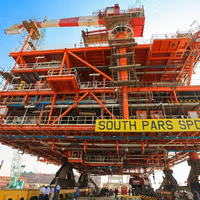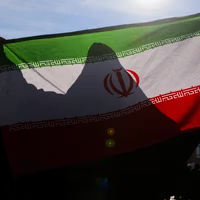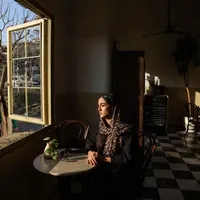Iran's Khamenei formally approves Pezeshkian as president

Iran's Supreme Leader Ali Khamenei gave the official mandate for the presidency to Masoud Pezeshkian on Sunday in a ceremony attended by various officials and dignitaries.

Iran's Supreme Leader Ali Khamenei gave the official mandate for the presidency to Masoud Pezeshkian on Sunday in a ceremony attended by various officials and dignitaries.
During the ceremony -- called Tanfiz, Khamenei handed over a decree, known as the "decree of confirmation" or "decree of validation", to the president-elect, formally recognizing him as the legitimate president.
In fact, the official government news website, IRNA, used the word "approved" for Khamenei's endorsement of Pezeshkian as President, who is considered to be the chief executive from today, July 28. Therefore, the second inauguration event in the parliament in two days, is indeed a ceremonial swearing-in.
The ceremony started with Interior Minister Ahmad Vahidi delivering a report on the process of snap election following the death of late President Ebrahim Raisi, who died in a helicopter crash on May 19 along with his accompanying delegation including Foreign Minister Hossein Amir-Abdollahian.
Following Vahidi's speech, Mohammad Mohammadi Golpayegani, the head of Khamenei's office, read out the decree issued by the Supreme Leader of the Islamic Republic, officially confirming the appointment.
The new president then delivered a speech, emphasizing that he will follow Khamenei's orders and calling for the resolution of political differences. "The responsibility that the Constitution has placed on me is to move towards the clear path outlined by the Supreme Leader."
Khamenei also delivered a speech notably avoiding attacks on the United States but reiterating his rhetoric against Israel and support for anti-West, anti-Israel militant groups backed by Tehran. He also stated that relations with European countries are not Tehran's priority, while calling for stronger ties with regional neighbors.
In his address, Khamenei launched an unusually long and harsh critique of the pre-1979 monarchy, insisting that the Islamic Republic provides democratic choice, whereas the pro-West king, Mohammad-Reza Pahlavi, relied on the United States and Britain to stay in power.
This attack, during an inauguration ceremony, may reflect Khamenei's realization that the Islamic Republic has lost popularity with many Iranians, who have abstained from voting in several elections since 2020. Khamenei's authoritarian rule has increasingly used military force to quell anti-regime protests, killing thousands of citizens since 2017.
The ongoing economic crisis in Iran has fueled nostalgia for the prosperity of the Pahlavi era, especially in the 1970s.
The Tanfiz ceremony will be followed by Tahlif slated for Tuesday, when Pezeshkian swears in before the parliament. During Tahlif, the newly elected president takes an oath before the Parliament (Majlis) in the presence of the head of the judiciary and the members of the Guardian Council, promising to uphold the constitution and faithfully execute his duties as the head of state. Both ceremonies are essential in the transition of presidential power, ensuring both legal and symbolic legitimacy for the incoming president.
According to IRNA, over 2,500 attendees are expected, including national and military officials, heads and professors from religious and academic institutions, representatives from various sectors, families of martyrs, and foreign ambassadors stationed in Tehran.
The state media also said that 70 foreign delegations from different countries and international organizations will attend the swearing-in ceremony.
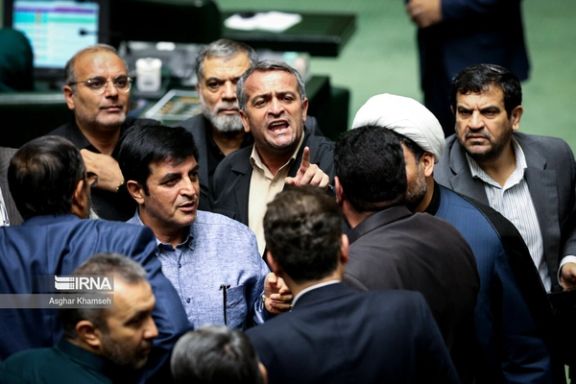
Post-election dynamics among Iranian politicians, particularly conservatives, appear to be about control over state entities where public funds originate and appropriations supervised.
Several cabinet ministers of the outgoing Raisi administration and some of the aides of Parliament (Majles) Speaker Mohammad Bagher Ghalibaf fiercely clashed throughout the week over the top position at the Iranian Parliament's Audit Office. This body plays a crucial role in distributing funds to well-connected individuals and organizations.
Among the candidates for the post were the Audit Office's current chairman Ahmad Reza Dastgheib, Raisi's Road Minister Mehrdad Bazrpash, his Minister of Economy Ehsan Khandouzi and his Planning and Budget Chief Davoud Manzour.
At the Majles session on July 24, the incumbent chairman, Dastgheib, was re-elected. Despite his close ties to the Raisi administration, he is considered a moderate politician compared to the other contestants.
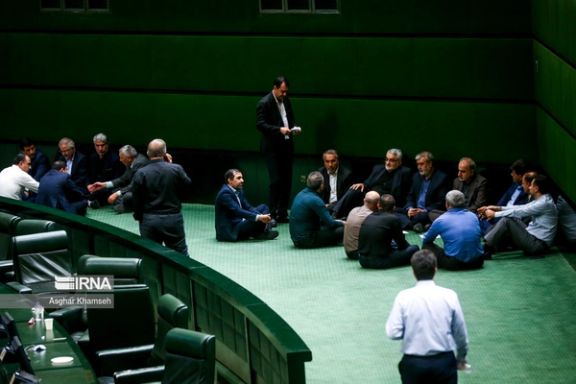
From Ghalibaf's camp, Mohsen Pirhadi and two others had declared their candidacy for the post. Other conservative groups also put forward their own candidates. However, President-elect Masoud Pezeshkian did not name any candidates, as his key officials, who will likely be announced next week, still need to be vetted by the Majles.
The Audit Office is tasked with making sure that the country's annual budget is being spent in the right way and is distributed fairly among all the government bodies and tens of religious and state ideological organizations whose functions are not clearly defined. Meanwhile, it can conduct investigations on the spendings of al those organizations. This makes it a good leverage to distribute government funds and control rival organizations through its checks and balances.
Furthermore, the post has proven to be a good launching pad for higher state positions. Its former top officials have invariably risen to higher ministerial or vice president levels.
On the other hand, at least two top ultraconservative politicians—presidential candidate Saeed Jalili and fundamentalist commentator and vigilante leader Ali Akbar Raefipour—appear to be in significant trouble. They are under pressure to disclose the funding sources for Jalili's "shadow government" and Raefipour's "Masaf" organization. The former is a self-declared parallel cabinet, while the latter aims to send as many hardliners as possible to the Iranian parliament in March.
The Iranian Judiciary has indicted Masaf and Raefipour for tarnishing the image of Ghalibaf during the March 2024 parliamentary election when Masaf was not able to send more than a handful of new lawmakers to the Majles. Rumors on social media and reports in newspapers point fingers at Ghalibaf as the man behind the indictments for Raefipour, two journalists and a whistleblower who made disclosures about mishandling of funds by Ghalibaf and other cases involving his family members.
In a detailed report on Tuesday, the Khabar Online website questioned the non-transparent funding and expenditures of Jalili's shadow government. The report quoted over two dozen politicians who criticized Jalili and his so-called "rival government." They argued that, despite the unclear objectives of this "government," its existence violates political norms, as shadow governments are typically formed by political parties with well-defined platforms.
Khabar Online further charged that Jalili's shadow government has no charter or articles of association, and its members are not known. Others have called on Jalili to clarify his source of funding, and the names of those who control the shadow government's bank accounts out of which hefty sums have been paid for his unsuccessful election campaign. They further charged that Jalili's shadow government is an illegal entity.
Jalili has remained silent, offering no explanation to clarify the opaque situation of his "government."
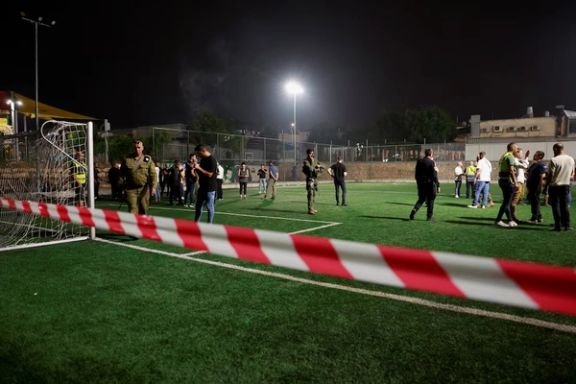
A rocket strike on a soccer field in Golan Heights on Saturday killed at least 11 people, including children and teenagers. Israeli authorities have blamed Lebanon's Iran-backed Hezbollah for the attack, raising fears of a broader regional conflict.
Hezbollah quickly denied any involvement in the attack. Mohammed Afif, Hezbollah's chief spokesman, told The Associated Press that the group "categorically denies carrying out an attack on Majdal Shams", a Druze village in Israeli-controlled Golan Heights.
However, the Israeli military says the rocket used in the attack was “a Falaq-1 rocket, an Iranian rocket, manufactured in Iran, a rocket with a warhead of over 50 kilograms of explosives."
Speaking in a press conference, Rear Admiral Daniel Hagari, the Israeli military's chief spokesman called it a "very serious" incident and promised to act accordingly.
"Hezbollah fired a rocket at children playing soccer in northern Israel. It then lied and claimed they did not carry out the attack," said Hagari. He noted it was the deadliest assault on Israeli civilians since the October 7 Hamas attack that ignited the war in Gaza.
Middle East affairs expert Menashe Amir told Iran International, "It was tolerable over the past 10 months as long as Hezbollah only sent a single rocket, missile, mortar, or drone, even in cases where minor damage was caused, and even when one person, whether military or civilian, was killed. But today, two horrific incidents have occurred that have put Israel at a crossroads."
"One was an attack on a gas field in the Mediterranean Sea, and much worse, was an attack on a soccer field that led to the deaths of 10 Druze children. They were Arab Druze to whom Israel had granted citizenship. This is what has put Israel at a crossroads, compelling it to respond," Amir said.
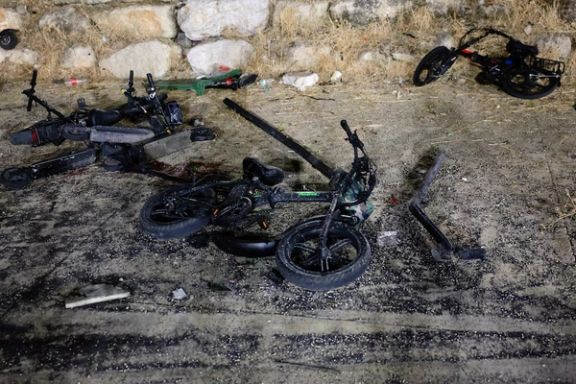
Israeli Prime Minister Benjamin Netanyahu, who was visiting the United States, announced he would cut his trip short in response to the attack. He said he was “shocked” to see the attack, pledging that Israel will “not let this pass in silence.”
“Among the murdered were small children who were playing soccer,” Netanyahu said in a video statement, “and others were also other murdered. Our hearts are all broken by these sights.”
Iran’s reaction
Mojtaba Amani, Iran’s ambassador to Lebanon, referred to the deadly attack on Majdal Shams and said, "We do not expect Israel to start a war against Lebanon and the region; considering the balance of power, we believe the likelihood of such an event is very low."
Mohsen Rezaei, a former chief-commander of the Revolutionary Guard, also wrote on X that “Netanyahu, out of desperation or madness, believes that by starting an adventure in Lebanon, he can escape the quagmire of Gaza; however, he is stepping towards a deeper and more formidable quagmire.”
Since its establishment in 1979, Iran's Islamic government has been a staunch adversary of Israel and the United States. In the early 1980s, it established Hezbollah in Lebanon as a proxy force to confront Israel. Over the past two decades, Iran has created additional proxy forces in Iraq, Syria, Yemen, and the Palestinian territories. Furthermore, it has developed networks across other Middle Eastern, African, and Western countries.
International reactions
Lebanon's government, while not specifically mentioning Majdal Shams, called for an "immediate cessation of hostilities on all fronts" and condemned all attacks on civilians.
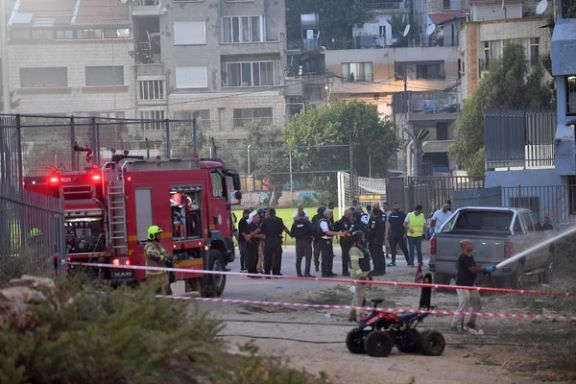
The attack also sparked shock and fear among American politicians, with several House Representatives blaming Iran for the bloodshed. Maryland Congressman Steny Hoyer stated that the attack on Majdal Shams "is further evidence that Israelis are under siege by Iran and its proxies including Hamas, Hezbollah, and the Houthis.
He also called it "another example of the Iran-sponsored reign of terror in the north of Israel where tens of thousands have been displaced since 10/7."
House Representative Lois Frankel condemned the attack on X, saying, "Israel remains under constant threat from Iran and its proxies. We must continue to stand by our ally as she defends herself from terror."
New York Representative Anthony D’Esposito also blamed Iran, stating, "The USA must stand resolutely behind Israel and reject the aggression of Iran and their terror proxies like Hezbollah and Hamas."
In 2018, the US government reported that Iran provides Hezbollah with an estimated $700 million annually. Earlier, in 2016, Hezbollah's leader, Hassan Nasrallah, publicly stated in a speech that his organization’s funding comes directly from Iran.
This funding supports Hezbollah’s extensive military capabilities, which include an arsenal of approximately 150,000 missiles and rockets aimed at Israel. The financial support from Iran allows Hezbollah to maintain its militant activities and exert considerable influence in Lebanon and beyond.
The bigger picture
Saturday's attack coincides with negotiations between Israel and Hamas regarding a potential cease-fire to end the nearly 10-month conflict and secure the release of approximately 110 hostages held in Gaza. The war began with a surprise Hamas attack on October 7, which killed around 1,200 people and led to Israel's retaliatory offensive, resulting in over 39,000 deaths, according to Hamas health authorities.
The Saturday rocket strike follows earlier cross-border violence between Israel and the Lebanon-based Shia militia on Saturday, where Hezbollah reported the deaths of three fighters. Israel’s military confirmed an airstrike on a Hezbollah arms depot in the border village of Kfar Kila, indicating militants were present at the time.
Israel and Hezbollah have also been exchanging fire since October 8. Recent months have seen increased cross-border violence, with Israeli airstrikes and Hezbollah's rocket and drone attacks reaching deeper into each other's territories.
Since October, Israeli airstrikes in Lebanon have killed more than 450 people, primarily Hezbollah members, along with about 90 civilians and non-combatants. On the Israeli side, 44 people have been killed, including at least 21 soldiers.
Looking forward
As the situation escalates, Israel faces critical decisions on how to respond to the latest attack. Menashe Amir believes the potential for a severe military reaction against Hezbollah or even broader targets in Lebanon is high. However, such actions carry the risk of sparking an all-out war, with devastating consequences for the entire region.
“If Israel now enters an all-out war with Hezbollah, the militant group has long-range precision missiles capable of launching severe, deadly, and destructive attacks on numerous locations within Israel. Israel has no choice but to respond with a crushing reaction, which could, however, escalate into a full-scale war," Amir said.
Another critical question is the potential response from Hezbollah's main sponsor, Iran. If Tehran gets engaged in the war, "the consequences of such a conflict for the Middle East would be extremely destructive. Hezbollah's precision missiles can target many areas within Israel, while Israel's powerful air force can devastate numerous areas inside Lebanon,” Amir told Iran International.
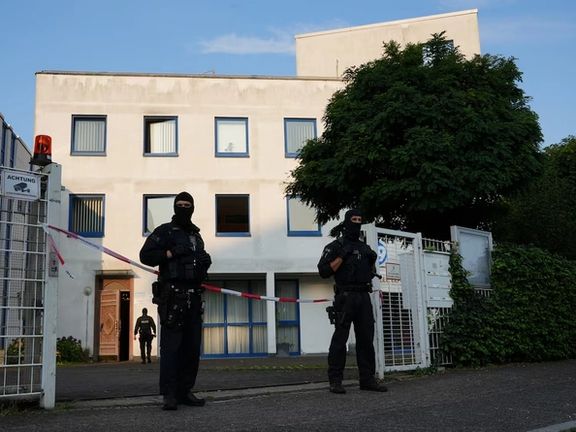
Iran's Acting Foreign Minister Ali Bagheri Kani warned Germany on Saturday that its closure of Tehran-linked Islamic centers will have consequences.
On Wednesday, Germany’s Interior Ministry announced the ban on the Islamic Center Hamburg (IZH) and its subsidiary organizations, citing their radical Islamist goals and direct control by Tehran. Authorities searched 53 premises across eight German states under a court order.
In a phone call with German Foreign Minister Annalena Baerbock, Iran's top diplomat expressed Tehran's protest at the closure of the Islamic centers, calling it a "politicized, Islamophobic move".
"The German government must accept the consequences," Bagheri warned, according to Iran's readout of the call.
Iran's Foreign Ministry earlier summoned German Ambassador to Tehran Hans-Udo Muzel, expressing Tehran's "strongest protests" over what it termed a "hostile act." The ministry’s official website described the closure as an "obvious case of Islamophobia" and accused Germany of promoting "an intentional spread of violence and dictatorship."
The German Interior Ministry argued that the Islamic Center, despite claiming to be a purely religious foundation, operated as an "Islamist extremist" entity directly representing Iran's supreme leader to advance an "authoritarian and theocratic rule."

Germany's federal police had previously raided the Islamic Center in November 2023 on suspicions of supporting the Lebanese militant group Hezbollah, which is accused of engagement in terrorism. Germany banned Hezbollah's activities in 2020, asserting that the IZH's actions aimed to spread the revolutionary concept of Iran’s Supreme Leader and undermine Germany’s "constitutional order."
The ban impacts the Hamburg-based IZH, known for its turquoise mosque, and its subgroups in Frankfurt, Munich, and Berlin. Consequently, four Shiite mosques will be closed, according to the ministry.
"The Islamic Republic uses these centers when they face diplomatic restrictions at embassies," Munich-based journalist Masoud Kazemi told Iran International. "For instance, in the case of Iranian diplomat convicted of terrorism (Asadollah Assadi), there were reports that he, under the cover of a diplomat, who planned to bomb an MEK gathering with the help of some other individuals, had met with those people at the Islamic Centre Hamburg and exchanged money with them."
Kazemi said another responsibility of these centers is to attract Shiites who have immigrated, been expelled, or sought asylum in Europe. "Shiites from Lebanon, Azerbaijan, Turkey, Yemen, Syria, and Iraq. They hire them culturally and structurally and use them on different occasions. It is also said that the large number of worshippers and mourners attending ceremonies in Europe are organized by these centers, serving as a show of power by the Islamic Republic in the heart of Europe."
The IZH has been a hub of pro-Hezbollah activism and support for Qasem Soleimani, the former commander of IRGC's Quds Force. In early 2023, the German Federal Administrative Court ruled that the IZH and its affiliated Blue Mosque are "extremist Islamic organizations."
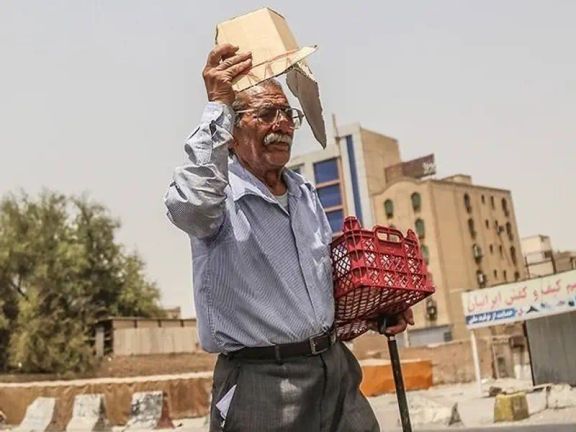
As Iran battles a heatwave, the nation's energy infrastructure is under severe pressure, exposing the government's long-standing failures and mismanagement.
In the face of rising temperatures and heat, the Iranian government has announced the closure of government offices and banks nationwide on Sunday, July 28.
Ali-Akbar Mehrabian, the Minister of Energy, has acknowledged the challenges in producing and supplying electricity, highlighting the increasing pressure on the power grid. "From today on, it will become increasingly difficult to produce and supply sufficient electricity," Mehrabian stated, adding that each one-degree increase in temperature puts an additional 2,300 megawatts of pressure on the grid.
Heatwave strains an already fragile system
The current heatwave has seen temperatures in Tehran reach 40 degrees Celsius for the second consecutive day, while Varamin, a town near the capital, recorded a temperature of 43.2 degrees in the past 24 hours. Delgan in Sistan-Baluchestan province hit 50 degrees Celsius, making it the hottest city in Iran. Bafgh in Yazd province also saw temperatures rise to 49.3 degrees, setting a new record over the past 50 years. According to the Meteorological Organization, the peak of this heatwave is expected between July 24 and 28.
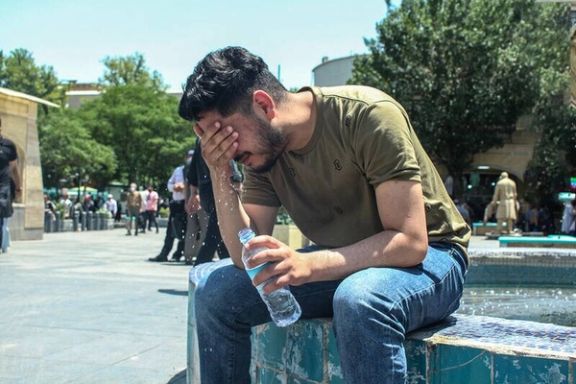
The Iranian government's response to the crisis has been to declare a holiday, shutting down all government offices and banks (excluding emergency and rescue services) on Sunday. Earlier, working hours for government offices on Saturday were cut short to 10 AM.
On July 25, Mehdi Abbasnejad Najafabadi, a climate change researcher, warned about the extreme heat and increased UV radiation, urging people to stay indoors. This advice came too late for the 225 people who had already been hospitalized due to heatstroke, according to Babak Yektaparast, spokesperson for the National Emergency Organization.
Underinvestment and mismanagement
The root of Iran's energy crisis lies in underinvestment and mismanagement. Mostafa Rajabi Mashhadi, spokesperson for Iran's electricity industry, predicted that electricity consumption would exceed 77,514 megawatts in the next two weeks, setting a new record.
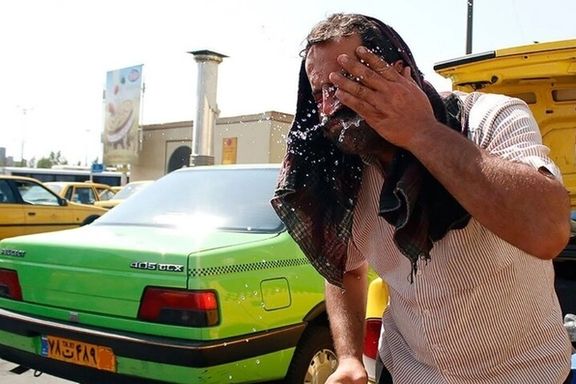
Omid Shokri, an Istanbul-based Senior Researcher at George Mason University and Energy Expert, criticized the Iranian government for failing to invest adequately in the energy sector.
"The Iranian government needs to spend at least 6 billion dollars annually to meet the country's electricity needs, but this target has only been achieved once in the past 15 years (in 2010)," Shokri said.
"As long as sanctions remain in place and the FATF issue remains unresolved, the energy crisis will continue to worsen daily for the Iranian people," he added.
The consequences of the government's inability to provide electricity are severe. In addition to affecting homes, recent weeks have seen power cuts or quota-based distribution for offices, industrial estates, and industries. This has plunged hundreds of cities and villages into darkness during the peak summer heat multiple times.
Mansour Sohrabi, an expert in ecology and environmental science, emphasized the inefficiency of Iran's energy policies. "Most people in Iran use water-based air conditioners, with nearly 30 million such units in use across the country. These consume a significant amount of water and electricity," Sohrabi explained.
"The government's plans are not compatible with climate change, and they must be adjusted to address climate change accordingly."
The halt in investment in the electricity industry, the lack of development of power plants, and the aging grid are the main reasons for the electricity imbalance and the 14,000-megawatt shortage in Iran. As experts have pointed out, the government's failures are pushing the country towards an increasingly unsustainable future, with ordinary citizens bearing the brunt of this mismanagement.
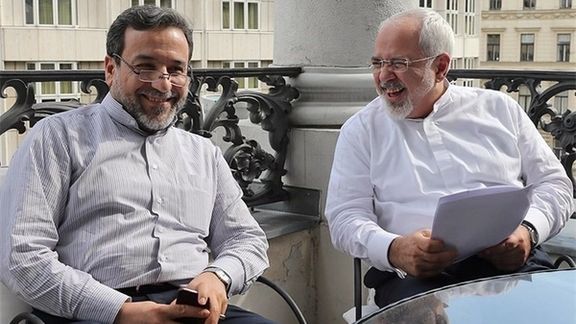
A major political news website in Iran reported on Saturday that the country's new president has already picked his foreign minister and head of the nuclear organization.
Nameh News reported that former Deputy Foreign Minister Abbas Araghchi, who was the chief nuclear negotiator with the West in 2021 has been selected as the prospective foreign minister. However, no official announcement has yet been made.
The report also said that long-time diplomat and top-level official Ali-Akbar Salehi will head the Atomic Energy Organization of Iran.
Pezeshkian will be officially inaugurated as the next president on Sunday, July 28, in a ceremony presided over by Supreme Leader Ali Khamenei. Two days later, he will take the oath of office in the parliament. According to parliamentary law, the new president is required to present his agenda and introduce his cabinet ministers within two weeks of his inauguration.
No names or lists of ministers is considered final until the president officially submits his proposed appointees to Supreme Leader Ali Khamenei.
During Pezeshkian's presidential campaign, initial speculations pointed towards former Foreign Minister Mohammad Javad Zarif as a key cabinet member. However, shortly after Pezeshkian's victory, Zarif announced that he would not be joining the administration.
Instead, he was appointed as the head of the Strategic Council for Transition, tasked with identifying and recommending ministerial candidates.
Asr-e Iran, a moderate-conservative website, on Thursday claimed that it has identified the three potential candidates for the foreign minister role selected by the committee, from whom Pezeshkian must choose.
All candidates belong to the reformist faction: former Deputy Foreign Ministers Abbas Araghchi and Seyyed Mohammad Sadr, who also served as Deputy Foreign Minister for Arab and African Affairs, and academic and former Ambassador to Russia, Mehdi Sanaei.
Earlier in July, the IRGC-affiliated Tasnim news agency also identified Araghchi as the "most probable" candidate for the foreign ministry.
Tasnim also asserted that Pezeshkian's message to Hezbollah leader Hassan Nasrallah, was authored by Araghchi.
Araghchi, served as deputy to Zarif during Hassan Rouhani's presidency, which concluded in mid-2021. He was Zarif's right-hand man during talks that led to the 2015 JCPOA nuclear deal.
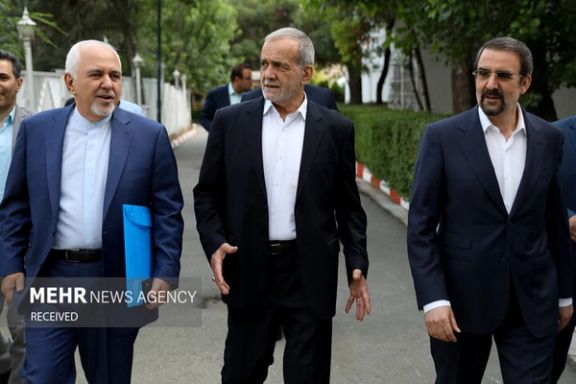
Another potential candidate named in the media is Mehdi Sanaei, who served as Iran's Ambassador to Russia, Senior Advisor to the Foreign Ministry, and a former Member of Parliament. The Iranian media highlight his fluency in English, Russian, and Arabic, recognizing him as both a practitioner and a professor in international relations.
During political roundtables and election debates, Sanaei served as one of Pezeshkian's political advisors, leading the media to believe that he was one of Pezeshkian's candidates for the Ministry of Foreign Affairs.
In 2019, Sanaei found himself at the center of a significant controversy following the death of his daughter in Moscow, described as an apparent suicide. The Iranian embassy announced Arefe Sanaei's passing on social media but denied suicide as the cause, attributing her death to a "brain stroke."
Contradictorily, a local TV station reported that the ambassador's daughter fell from a ninth-floor window onto a Renault car, resulting in her death. Radio Free Europe/Radio Liberty (RFE/RL), a US-funded news organization, corroborated this account, confirming local media reports that Arefe Sanaei fell onto a car in the street.
Supreme Leader Ali Khamenei has consistently reiterated his priorities, which include supporting proxy groups in the region and steadfastly advancing the nuclear program. In his latest speech, he praised the parliamentary-approved "Strategic Action Plan to Lift Sanctions and Protect the Iranian Nation’s Interests," which mandates the government to increase uranium enrichment and reduce UN inspections According to Zarif, this law has been a significant obstacle to achieving meaningful progress in negotiations.


